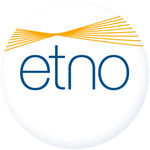Difference between revisions of "ETNO"
| Line 10: | Line 10: | ||
| businesses = | | businesses = | ||
| products = | | products = | ||
| − | | employees = | + | | employees = |
| − | | revenue = | + | | revenue = €225 billion (2009) |
| website = [http://www.etno.be/Default.aspx etno.be] | | website = [http://www.etno.be/Default.aspx etno.be] | ||
| blog = | | blog = | ||
Revision as of 15:39, 23 September 2011
| Founded: | Brussels, 1992 |
| Headquarters: | Avenue Louise 54 1050 Brussels, Belgium |
| Revenue: | €225 billion (2009) |
| Website: | etno.be |
| LinkedIn: | ETNO |
| Key People | |
| Thierry Dieu, Acting Director, Communications Manager Josef Leonard Debecker, Advisor consultant Caroline Greer, Regulatory Affairs Manager Anne Valles, HR & Financial Officer Isabelle Claeys, Events & Operations Coordinator Joanna Fliszewska, Secretary | |
ETNO is the abbreviation for European Public Telecommunications Network Operators Association. It was established in 1992 and is based in Brussels, Belgium. The ETNO has become one of the most vital policy groups for European electronic communications network operators. [1]
Members
Members of ETNO can be classified into two classes:
Full members: These consist of undertakings that provide electronic communications networks over mobile, fixed or personal communications systems.
Associate Members: These are undertakings that provide electronic communications services who contribute towards the work of ETNO.
All these members are from countries that are located within Europe and provide their services within Europe.[2]
Structure
The ETNO follows a 3-tier structure comprising of the General Assembly, the Executive board, and the Working Groups and Special Rapporteurs.
General Assembly: The General Assembly consists of the all ETNO members. It is the highest decision-making body. Its decisions are mostly reached by majority consensus and are ultimately implemented in framing policies for ETNO and for its administration.
Executive Board: This board consists of 11 members, which includes a chairman who is elected by the General Assembly. This board is charged with conducting the management functions of the association. Its main agenda is to promote and evaluate proposals regarding internal rules, membership matters, external initiatives, and so on.
Working Groups and Special Rapporteurs: These groups deal with myriad topics, ranging from R&D to various EU policy matters. The working groups are assigned with tasks that are temporary, thereby making their functions more issue-based than structure-based. [3]
Objectives
To establish a constructive dialogue between the decision-makers, its member companies and other forces contributing in the development of the European Information Society for the benefit of users.[1]
Facts and Figures
The ETNO represents 41 operators in 35 European countries extending the boundaries of the European Union (EU). Investments made by members of the ETNO alone account for two-thirds of investments made in the European telecom sector. Out of these, 43% of its investments are made into mobile operations and 57% are made into fixed operations, which includes broadband networks.[4]
ETNO and ICANN
The ETNO has always welcomed the opportunity to comment on the functioning of ICANN. In document in response to the U.S. Department of Commerce (DOC) on the review of Joint Project Agreement (JPA) with ICANN, the ETNO reiterated that it is always committed towards providing all the support necessary to ICANN. It also commended ICANN over its progress in the arena of expansion of gTLDs and towards distribution of the Internationalized Domain Names (IDN). ETNO has also stated that ICANN has succeeded in properly reorganizing itself and has addressed all the issues of its stakeholders convincingly. It is in strong support of the private multi-stakeholder model that ICANN is built on.[5]
